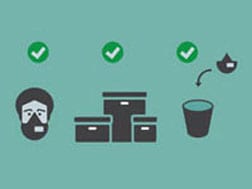Healthcare Respiratory Protection Resources
Proper Respirator Use, Storage, Maintenance, Repair, Disposal
NIOSH Documents
Hospital Respiratory Protection Program Toolkit
This toolkit was developed to assist hospitals in developing and implementing effective respiratory protection programs, with an emphasis on preventing the transmission of aerosol transmissible diseases (ATDs) to healthcare personnel.
Healthcare personnel are paid and unpaid persons who provide patient care in a healthcare setting or support the delivery of healthcare by providing clerical, dietary, housekeeping, engineering, security, or maintenance services. Healthcare personnel may potentially be exposed to ATD pathogens. Aerosols are particles or droplets suspended in air. ATDs are diseases transmitted when infectious agents, which are suspended or present in particles or droplets, contact the mucous membranes or are inhaled.
Implementing Hospital Respiratory Protection Programs: Strategies from the Field
Protecting workers from exposure to all types of respiratory hazards is an important issue for hospitals and other healthcare organizations. In order to address this often overlooked danger, The Joint Commission and Centers for Disease Control and Prevention (CDC), National Institute for Occupational Safety and Health (NIOSH), National Personal Protective Technology Laboratory (NPPTL) have collaborated to develop a new educational monograph designed to assist hospitals in implementing their respiratory protection programs (RPPs).
What’s Special about Chemical, Biological, Radiological, and Nuclear (CBRN) Powered Air-Purifying Respirators (PAPR)?
This guidance will help respiratory protection program administrators, managers, and powered air-purifying respirator (PAPR) wearers understand the special features of a NIOSH-approved chemical, biological, radiological, and nuclear (CBRN) PAPR. These respirators have unique performance, use limitations, and storage requirements compared to NIOSH-approved industrial PAPR. The respiratory protection program administrator should assure that PAPR manufacturer recommendations are addressed. This information may also be used by managers and PAPR wearers to optimize personal protection.
TB Respiratory Protection Program in Health Care Facilities
This manual is designed to serve as a practical guide for those individuals responsible for initiating and running a TB respiratory protection program in healthcare facilities. The information in this manual remains current and viable in 2012.
Filtering Facepiece Respirators with an Exhalation Valve: Measurements of Filtration Efficiency to Evaluate Their Potential for Source Control
This technical report summarizes research undertaken by the National Personal Protective Technology Laboratory (NPPTL) to provide improved science-based recommendations on the use of filtering facepiece respirators (FFRs) with an exhalation valve.
Infographics

Important Steps for Using NIOSH-Approved N95 Filtering Facepiece Respirators (2014)
Infographic listing five important steps for those who rely on a N95 for protection.
PDF [711 KB], Image [4,807 KB]

Sequence for Putting on Personal Protective Equipment (PPE)
Infographic detailing the proper sequence for donning PPE.
PDF [1.6 MB]

Facial Hairstyles and Filtering Facepiece Respirators (2017)
Infographic showcasing acceptable facial hairstyles for workers who wear tight-fitting respirators.
PDF [PDF 664 KB], Image [186 KB]
Fact Sheets
Institute of Medicine (IOM) Reports
Preventing Transmission of Pandemic Influenza and Other Viral Respiratory Diseases: Personal Protective Equipment for Healthcare Personnel Update 2010
In light of the unanswered research questions following the 2009 H1N1 influenza pandemic, NPPTL asked the IOM to assess the progress of PPE research and to identify future directions for PPE for healthcare personnel. While the IOM finds that there are gaps and deficiencies in the research about PPE use in health care, there is sufficient knowledge to recommend a four-pronged strategy for effective PPE use:
Blogs
Proper N95 Respirator Use for Respiratory Protection Preparedness
When outbreaks of infectious disease occur, we rely on healthcare professionals to care for those affected, putting themselves at increased risk of exposure to the pathogen causing the disease.
Skin Irritation from Prolonged Use of Tight-Fitting Respirators
Respiratory protection program managers, healthcare providers, and end users should understand how proper respirator fit and use can decrease skin irritation, as well as how to treat potential skin irritation caused by extended respirator use.
Videos
Respirator Safety: Donning (Putting on) and Doffing (Taking off)
Webinars
Debunking the Myths Regarding N95 Respirator Use
When it comes to N95s, workers may be confused about the purpose of these respirators, how to properly wear them, how to know if they are NIOSH-approved, and so much more.
Journal Articles
Proper use of surgical N95 respirators and surgical masks in the OR
Benson-SM; Novak-DA; Ogg-MJ
AORN J 2013 Apr; 97(4):457-470
Occupational health nurses’ achievement of competence and comfort in respiratory protection and preferred learning methods: results of a nationwide survey
Burgel-BJ; Novak-DA; Carpenter-HE; Gruden-M; Lachat-AM; Taormina-D
Workplace Health Saf 2014 Feb; 62(2):56-68
Perceived competence and comfort in respiratory protection: results of a nationwide survey of occupational health nurses
Burgel-BJ; Novak-D; Burns-CM; Byrd-A; Carpenter-H; Gruden-M; Lachat-A; Taormina-D
Workplace Health Saf 2013 Mar; 61(3):103-115
Understanding and controlling the hazards of surgical smoke
Novak-DA; Benson-SM
Prev Infect Ambul Care 2010 Dec; :1, 3-5
Emerging infectious threats: respiratory protection for personal safety
Messinger Harkavy-L; Santo-Novak-DA
Am Nurse Today 2009 Jun; 4(6):32
Evaluation of the benefit of the user seal check on N95 filtering facepiece respirator fit
Viscusi-DJ; Bergman-MS; Zhuang-Z; Shaffer-RE
J Occup Environ Hyg 2012 Jun; 9(6):408-416




